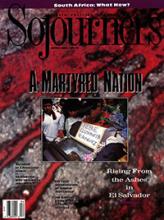The scene was shocking in its brutality. Peaceful demonstrators had gathered in the capital square to call for democratic reforms. The Chinese government responded with a show of force: Thousands of combat-equipped army units from around the country surrounded the protesters with tanks and armored personnel carriers. The troops moved in, firing indiscriminately into crowds of unarmed people. Hundreds were killed.
In the aftermath of the massacre, foreigners--especially Western journalists--were expelled. Government forces swept through the city, arresting demonstra-tors and publicly executing the leaders.
These events took place last spring in Lhasa, Tibet, prefiguring by months the carnage in Tiananmen Square that so shocked the world. And while outrage over the Tiananmen Square bloodbath continues to reverberate in U.S. and international politics, scarcely a whisper has been raised on behalf of the Tibetans.
Both ends of the political spectrum have rightly condemned the Bush administration, in the context of the continuing repression of the democracy movement in China, for kow--towing to the Chinese dictators by sending high-level emissaries to toast U.S.--China friendship, chipping away at sanctions against selling high-tech materials, vetoing legislation to protect Chinese students in the United States, and opening the door for new World Bank loans to China.
But the largely untold story of Tibet is, in some ways, a more horrible example of China's moral turpitude than the crackdown on the student freedom movement in that country. Tibet has one of the world's oldest civilizations, with a recorded history dating back to 127 B.C.E. Perched on a plateau in the world's tallest mountains, the Himalayas of central Asia, Tibet has for centuries been a bone of contention for its massive neighbors, China and India.
Read the Full Article
